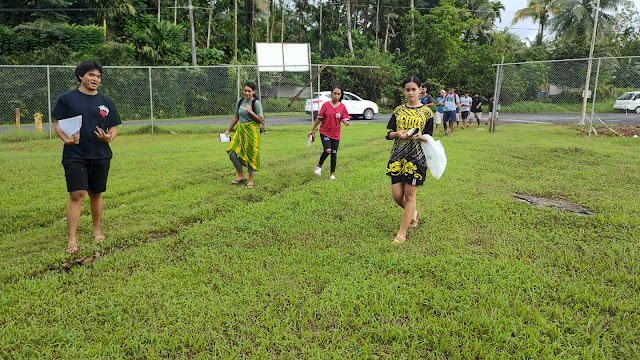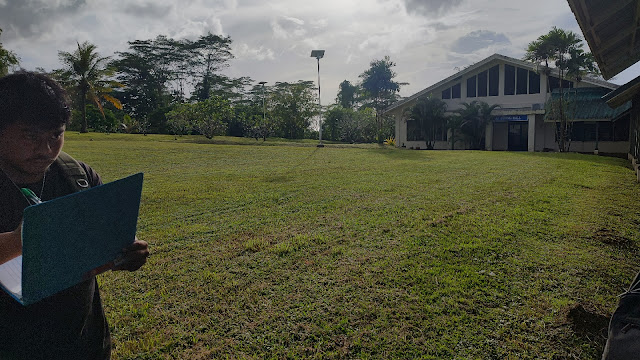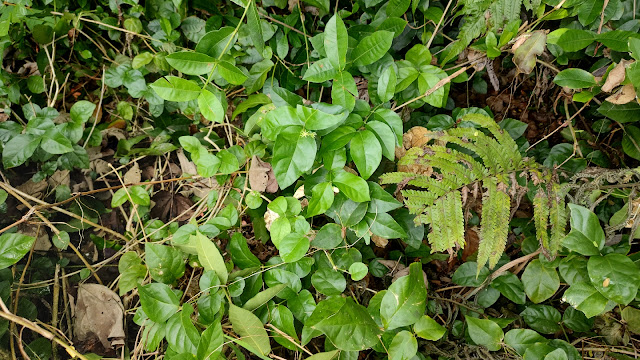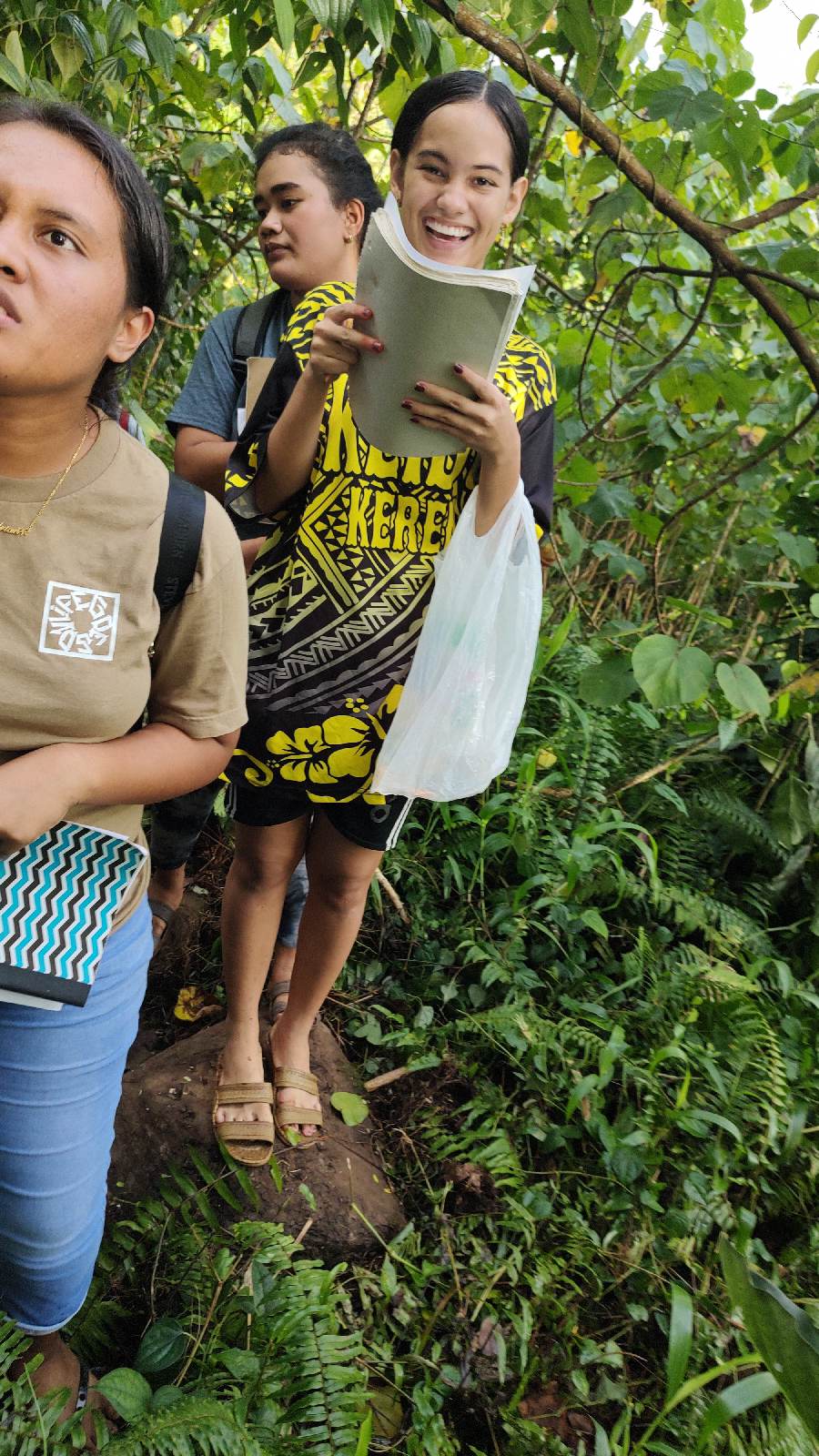Ethnobotany final
The ethnobotany field final left A101 at 16:20 on Thursday December 7. On the previous Tuesday the ground rules and guidelines were set down.
Notes for the field walk
- Wear appropriate clothes, sections of walk will be in the bush
- Wear appropriate footwear. A hat may be helpful.
- Bring something to write with - perhaps two things
- Prepare for wet conditions, be ready to cope with rain. Do not bring things that cannot get wet
- The field walk passes through a Pohnpeian and Japanese cemetery, avoid stepping or sitting on rocks in that area
- If pregnant, submit medical evidence (a prenatal care note or something) to be excused from the final
- The class leaves A101 at 4:20. If you join the class late, missed plants cannot be made up.
- The field final operates on an honor system. Work quietly. I want to know what you know, not what your classmate knows.
The directions shared with the students on Tuesday and repeated on Thursday were as follows:
This will be a field walk where I will ask you to identify the plant by local name and ask you to describe a use for the plant. The final will be on paper and will be done in the field on a walk across campus.
For the local use you must be specific. Do not simply put "medicinal plant" as almost all plants have some medicinal use. Be specific as to the use. Specify the illness or condition treated, the material culture item that is made, or the food that is made from the plant. The local use can be from anywhere in Micronesia.
The final starts at 4:20 PM on 07 December at A101 and then proceeds out around campus. You must be present to participate.
The local name will be the name in your language. For some students some of the plants will not have a local name. Those students get a pass on the local name but should still put a local use based on what they have learned in the course.
A link was provided to recently seen plants that might be seen again on a walk across campus.
The plants at the above link are not a comprehensive nor exhaustive list. Plants not on the list may be included on the day of the field final. Not all plants on the list will be included.
The final would cover 20 plants during the walk.
There was one absence at 4:20 and one female student excused on traditional cultural grounds.
Due to issues that arose last spring, photos were used more extensively this term to document the field final. The final also returned to being paper based to ensure students were not remotely participating as had occurred spring term.
This term students appeared to be more conscious of spreading out, although not all segments of the walk permitted spreadhing out.
At this location the students were identifying Volkameria inermis, Premna obtusifolia. Scaevola taccada, and Ocimum tenuiflorum. The Ocimum tenuiflorum is dying back and there are no volunteers replacing the plant. This is something I will probably need to address during the spring term.
Senna alata
The class then moved on to cover Artocarpus altilis, Campnosperma brevipetiolata, Microsorum scolopendria, Davallia solida, and Senna alata. This term there was a nice isolated example of Senna alata.
On the mango trees I picked up Microsorum scolopendria and Davallia solida.
The class does tend to get spread out when moving from location to location.
Weed whacking earlier in the week had led to loss of some of the Centella asiatica patch, but a few stragglers survived.
Here the students were more crowded together, but they worked quietly and individually.
With 26 students photos help me catch details that I cannot while in the field. Perhaps the student was making an online reference to a plant, but at that moment in the field I did not catch that he had phone out. I will add the specific guideline, "Keep your phone put away during this final: I want to know what you know, not what you can look up."
The sun broke out at this point in the walk.
West side arrival 4:46 PM.
I had cleared a trail on the previous Saturday to the Jasminum sambac, Cyathea nigricans, and on westward.
I had recommended not standing on rocks, not everyone followed this guideline. I asked the student to step down. The course is, afterall, SC/SS 115: science and social science. Culture and custom are part of the course.
Moving along the trail past Curcuma australasicum known locally as auleng and sometimes confused with kisiniong.
In back a student is considering the Curcuma australasicum.
At the Ixora casei. The class used to clean up the area with machetes, but fall 2019 was the last term in which the course used machetes. The students were no longer all skilled in safely using a machete. The syllabus for spring 2020 was reworked to not include any ethnogardening work.
Some students opted to return to the east to exit the area. This area was more slippery and muddy than the west exit. There is a need to find an alternate route out from the Ixora casei, perhaps by taking the path across the mound to the west.
At the bananas, Musa × paradisca, at 5:11 PM.
Again, the class remains relatively well spread out. I am standing on top of a small berm, a rise. We had to walk up the rise to reach the sugar cane. Unbeknownst to me at that moment was that a student had grabbed a rock while going up the berm and sliced open their finger on that rock. Another student would later tell me that the student had slipped, and that caused him to grab the rock. This injury would later require medical attention. Appropriate footwear cannot be overemphasized. Almost any nature walk on campus will encounter slippery areas due to mud.
These are final attendance photos from the field as a way to check to


































Comments
Post a Comment